ASM Metals HandBook Vol. 8 - Mechanical Testing and Evaluation
Подождите немного. Документ загружается.

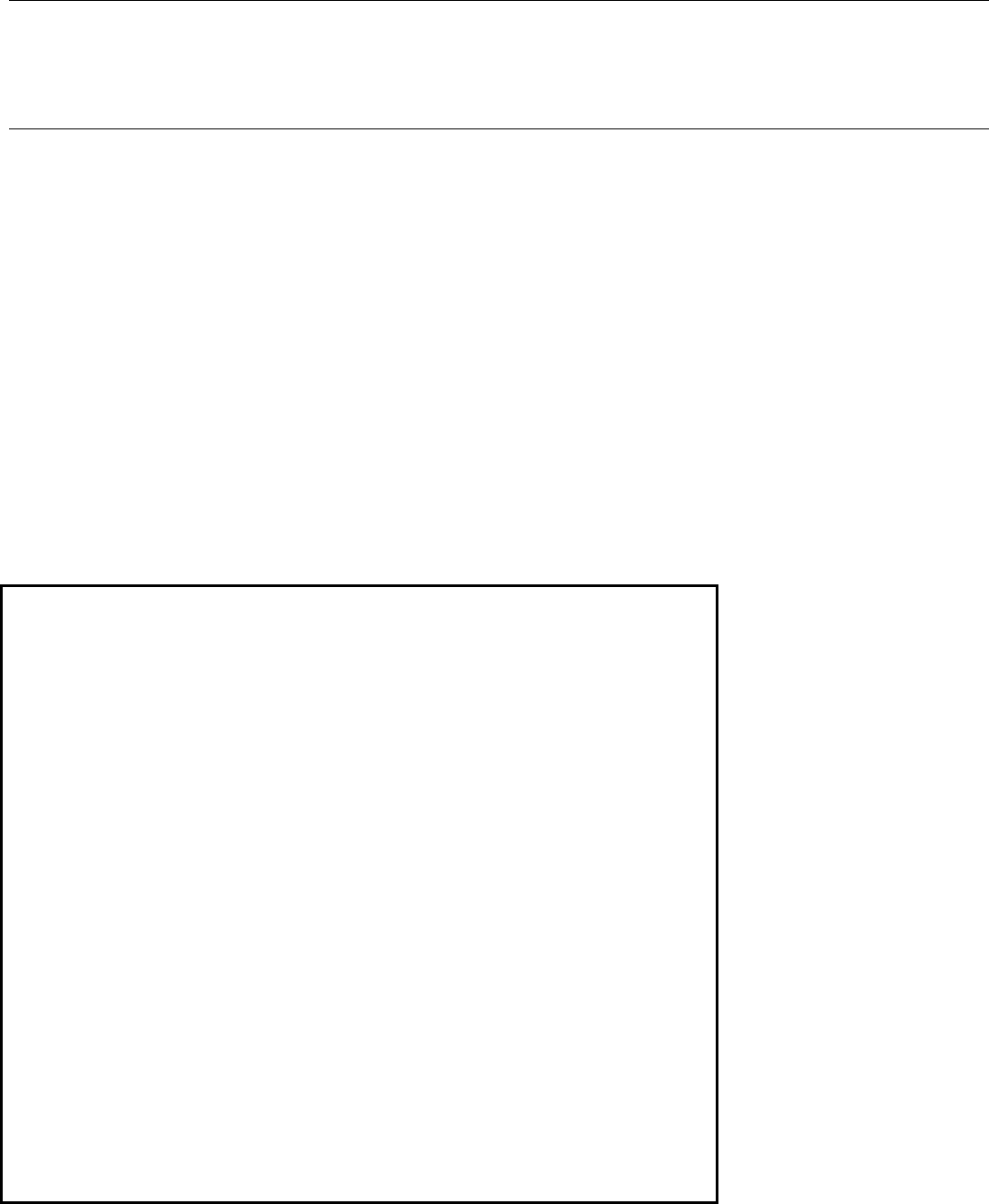
61. K. Kussmaul, and K. Maile, “Large Scale High Temperature Testing of Specimens and Components—
An Essential Tool for Structural Integrity Engineering,” International HIDA Conf., Paris, Commissariat
à l'Energie Atomique (CEA)/INSTN, Saclay/Paris, 15–17 April 1998, p 119–124
Residual Stress Measurements
Clayton O. Ruud, The Pennsylvania State University
Introduction
MANY METHODS and techniques have been proposed for the measurement of residual stresses. A
classification of techniques is provided in Welding, Brazing, and Soldering, Volume 6 of the ASM Handbook
(Ref 1), and this list is shown in Table 1. However, only a few of these techniques may be applied generally in
practice on items ranging from small components, such as bearing balls and rods, to very large structures, such
as bridges and aircraft. For some of the methods described herein, the component in which residual stresses are
to be measured must be brought to the measuring instrument. For others, the measurement devices are portable
and may be brought to the component (Fig. 1). In some cases it may be feasible to remove a section from the
component and bring that section to the residual stress measuring device. However, great caution must be
observed in sectioning a component, because it will change the stress field by relieving and/or inducing
stresses. The relieved stresses must be accounted for by the assumptions and reconstruction methods described
in the section “Stress Field Condition Assumptions and Reconstruction” in this article.
Table 1 Classification of techniques for measuring residual stress
A-1 Stress relaxation techniques using electric and mechanical strain gages
• Plate
o Section technique using electric resistance strain gages
o Gunnert technique
o Mathar-Soete drilling technique
o Stablein successive milling technique
• Solid cylinders and tubes
o Heyn-Bauer successive machining technique
o Mesnager-Sachs boring-out technique
• Three-dimensional solids
o Gunnert drilling technique
o Rosenthal-Norton sectioning technique
A-2 Stress relaxation techniques using apparatus other than electric and mechanical strain gages
• Grid system-dividing technique
• Brittle coating-drilling technique
• Photoelastic coating-drilling techique
B X-ray diffraction technique
• X-ray film technique
• X-ray diffractiometer technique
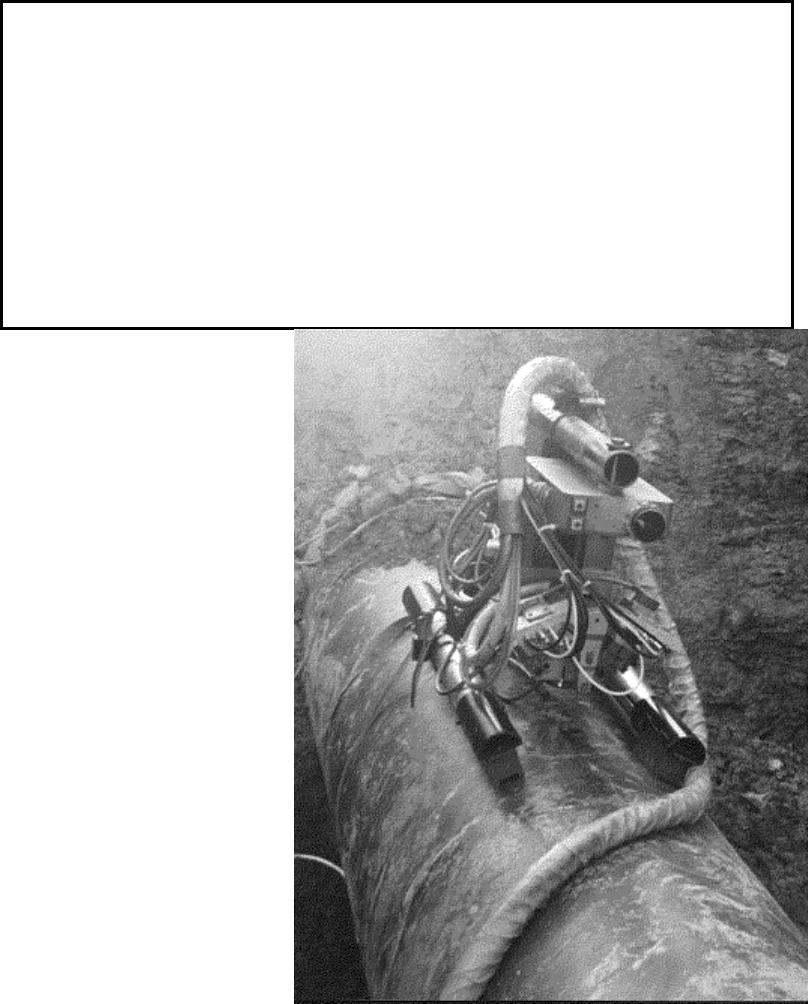
C Techniques using stress-sensitive properties
• Ultrasonic techniques
o Polarized ultrasonic wave technique
o Ultrasonic attenuation technique
o Hardness techniques
D Cracking techniques
• Hydrogen-induced cracking technique
• Stress-corrosion cracking technique
Fig. 1 Measurement of residual stresses on a gas pipeline in the field using a portable x-ray diffraction
instrument. (Courtesy of Proto Manufacturing)
Any manufacturing process that changes the shape of a solid, or where severe temperature gradients exist
during the process, causes residual stresses. These processes include the preparation of a specimen for testing as
might be performed for other tests described in this Volume. Fatigue testing is especially sensitive to surface
residual stresses, and specimens must be prepared with known, consistent residual stress conditions.
By their very nature, processes that change the shape of a solid cause nonuniform plastic deformation in the
solid, which leads to residual stresses. These processes include forging, rolling, drawing, machining, and so on.
Also, processes that produce high thermal gradients in a solid often lead to residual stresses. These processes
include quenching, casting, welding, and so forth. Further, processes that induce localized phase changes
produce residual stresses. These processes include martensitic hardening.
The residual stresses caused by manufacturing processes usually show very steep residual stress to distance
gradients as illustrated in Fig. 2. The steep gradients typical of residual stresses induced by manufacturing
processes may be cited as the cause of disagreement between residual stress measurements made by stress
relaxation techniques and those made by x-ray diffraction (XRD) techniques. The disagreement is nearly
always because the volume of the component in which the stress is measured is not the same in the two
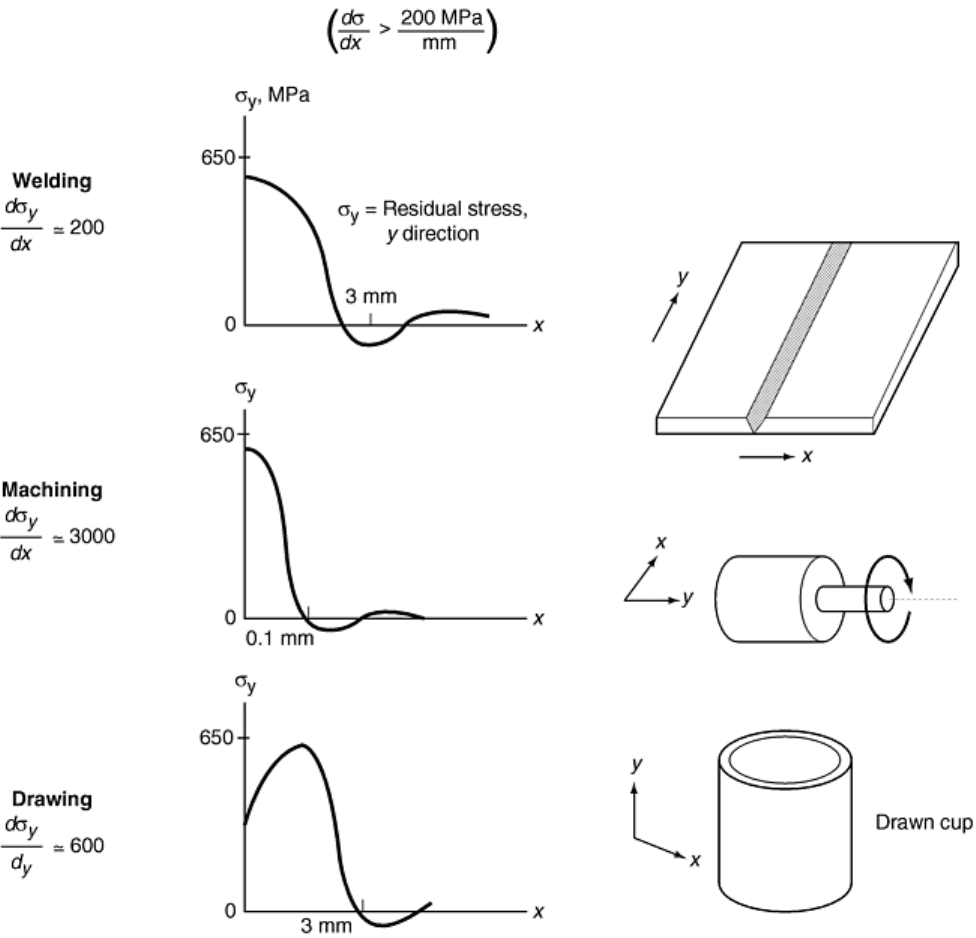
methods, and, thus, a different portion of the stress gradient is measured by each. Ruud et al. (Ref 2) showed
that the hole drilling method resulted in measured stresses approaching those measured at the surface by XRD
when the hole drilling results were extrapolated to the surface. Further, because of the steep gradients, stress
measurements must be performed at many locations in the manufactured solid in order to establish the
magnitude and distribution of the stress field of interest. Many researchers in XRD residual stress techniques
have focused on enhancing the accuracy of residual stress measurement and have ignored the fact that from a
practical standpoint, tens to hundreds of stress measurements are needed to define the stress field of interest.
Thus, many of the residual stress measurement techniques require too much time to perform and, thus, are
impractical. These include some of the techniques developed for XRD, strain gaging, and other methods.
Measurement times on the order of a second are available with XRD and some other methods, and automated
stress mapping has been performed with such techniques (Ref 3). Another concern in the measurement of
residual stresses in manufactured components is that the area or volume over which the stresses are resolved
must often be on the order of 1 mm (0.04 in.) or less. This is because the residual stress gradients re usually
quite steep, and measurement resolution larger than this tends to average the stresses to such an extent that the
high stresses are not detected.
Fig. 2 The residual stress magnitudes and distributions typical of a 650 MPa yield strength metal. For
example, in machining it is not unusual for the residual stress at the surface of the machined part to be
near the yield strength of the cold worked material.

Some characteristics of metals that can cause error in residual stress measurement by the methods described
herein include phase composition, plastic strain, grain size, crystallographic texture, and others. For example, in
a mixed ferrite/austenitic structure, the residual stresses in the ferrite are invariably different than those in the
austenite (Table 2). Also, Wimpory et al. (Ref 4) described the influence of varying amounts of cementite in a
ferrite matrix. The possibility of one or more of these microstructural characteristics causing error in residual
stress measurements performed by the methods described herein should be assessed by an expert in the method
selected. Details of the errors and their causes are not discussed in this article.
Table 2 Sample of residual stress readings from a 316 stainless steel pipe weldment
Stress
(a)
Distance from the weld fusion line
In austenite
In ferrite
mm in. MPa ksi MPa
ksi
1.02 0.04 -145 -21 -315
-46
1.80 0.07 -130 -19 -460
-67
2.80 0.11 -110 -16 -425
-62
3.80 0.15 -115 -17 -450 -65
(a) The precision of these measurement was ±3.0 ksi. Note that the ferrite places tensile stresses on the lattice of
the austenite while the austenite tends to compress the ferrite. Therefore, the more compressive the stress in the
ferrite, the less compressive the stress in the austenite.
The subsequent sections of this article discuss and describe the following:
• The need for measurement—the problem the engineer or metallurgist is trying to solve by obtaining
information about the residual stress field
• The nature of the residual stress fields in metals—examples of the magnitudes and distributions
• The strain basis for residual stress measurements—elastic strain measured, not stresses
• The destructive methods of residual stress measurement. These procedures are all based on sectioning or
removal of material to cause a redistribution of the residual stress, which is measured as a strain change.
These include most of the techniques listed under A-1, A-2, and D in Table 1.
• The semidestructive methods of residual stress measurement. These procedures are based on the same
principle as the destructive methods or on the perturbation of the residual stress field by other means,
but the extent of deformation is very small and usually repairable with little or no degradation in the
usefulness of the component. Semidestructive methods include some of the drilling and trepanning
techniques under A-1 and A-2, as well as the hardness techniques under C in Table 1.
• The nondestructive methods of residual stress measurement. These procedures do not permanently
disturb the residual stress field but directly measure the atomic lattice strain caused by the stress or
measure some physical property perturbed by the lattice strain. The nondestructive methods include the
techniques listed under B as well as ultrasonic methods, under C, and others to be described.
The purpose of this article is to provide an insight into the principles, practice, and limitations of residual stress
measurement procedures for metals. The article is not meant to provide sufficient detail for the performance of
the various methods described, but references are cited where such procedural details may be found, for
example, Gunnert (Ref 5), Moore and Evans (Ref 6), Constantinescu and Ballard (Ref 7), the SAE Handbook
Supplement (Ref 8), and Ref 9.
References cited in this section
1. K. Masubuchi, Residual Stresses and Distortion, Welding, Brazing, and Soldering, Vol 6, ASM
Handbook, 10th ed., 1993, p 1094–1102
2. C.O. Ruud, P.S. DiMascio, and J.J. Yavelak, Comparison of Three Residual Stress Measurement
Methods on a Mild Steel Bar, Exp. Mech., Vol 25 (No. 4), Sept 1985, p 338–343

3. J. Pineault and M. Brauss, Automated Stress Mapping—A New Tool for the Characterization of
Residual Stress and Stress Gradients, Proc. 4th International Conf. on Residual Stresses, Society for
Experimental Mechanics, Bethel, CT, 1994, p 40–44
4. R. Wimpory, G.M. Swallow, and P. Lukas, Neutron Diffraction Residual Stress Measurements in
Carbon Steels, The Fifth International Conference on Residual Stresses, Vol 2, Institute of Technology,
Linkopings University, Sweden, 1997, p 676–681
5. R. Gunnert, “Method for Measuring Triaxial Residual Stresses,” Document No. X-184057-OE,
Commission X of the International Institute of Welding, 1957, and Weld. Res. Abroad, Vol 4 (No. 10),
1958, p 1725
6. M.G. Moore and W.P. Evans, Mathematical Corrections in Removal Layers in X-Ray Diffraction
Residual Stress Analysis, SAE Trans., Vol 66, 1958, p 340–345
7. A. Constantinescu and P. Ballard, On the Reconstruction Formulae of Subsurface Residual Stresses
after Matter Removal, The Fifth International Conf. on Residual Stresses, Vol 2, Institute of
Technology, Linkopings University, Sweden, 1997, p 703–708
8. Residual Stress Measurement by X-Ray Diffraction-SAE J784a, Society of Automotive Engineers
Handbook Supplement, Warrendale, PA, 1971
9. A.J. Bush and F.J. Kromer, “Residual Stresses in a Shaft after Weld Repair and Subsequent Stress
Relief,” Paper No. A-16 presented at Society for Experimental Stress Analysis (SESA) Spring Meeting,
1979 (Westport, CT), 1979
Residual Stress Measurements
Clayton O. Ruud, The Pennsylvania State University
Need for Residual Stress Measurements
Before committing to measuring residual stresses in some component or workpiece, the engineer or metallurgist
must be sure that the reason for the need for measurement is clearly understood. The major reasons that residual
stresses are of concern are these:
• Failures that are suspected to be due to fatigue, stress corrosion, corrosion fatigue, or hydrogen
embrittlement
• Assessment for the continued serviceability of a component, for example, life assessment. This is
usually focused on a concern for in-service failure.
• Inconsistent test results on a machined or otherwise manufactured test specimen, especially in fatigue
testing
• Distortion occurring during processing of a component
• Distortion of components during storage or in-service
In the first three situations (where failure is of concern), surface stresses are usually of greatest interest, and
surface measuring procedures and techniques that provide optimum spatial resolution are needed. These are
required in order to identify the location and magnitude of the highest tensile residual stress, because those
stresses and locations are likely to dominate the failure conditions. In the last two situations, where distortion is
of concern, the stress field contour through the cross section of the component is usually most relevant and not
the location or magnitude of the maximum tensile residual stress. In these cases, procedures or methods that
provide measurement of stresses through the cross section are more relevant than spatial resolution.
It is extremely important that the investigator understand the mechanism for the inducement of the residual
stress field of concern. Most cases of suspected harmful residual stress fields are induced by manufacturing
processing or repair procedures, although sometimes abusive service conditions or an accident may have caused
them (Ref 10). When manufacturing processes or sometimes repair procedures are judged the most likely
sources of the residual stresses, it is often possible to predict the magnitude and distribution of the residual
stresses. Such information may be obtained through consulting the literature or applying computer modeling
(Ref 11, 12, 13, 14, 15, 16, 17, 18, and 19). A preconceived model of the residual-stress field will aid the
investigator in determining the best method for residual stress measurement and the location and number of
measurements that need to be made.
Nevertheless, sometimes the source and cause of the residual stress field is not evident, and the investigator is
compelled to perform measurements as a means to determine the cause. In such cases, measurement methods
and location must be selected without the aid of a priori knowledge of the stress field, and it is prudent to
consult the literature and experts in the field of residual stress measurement and manufacturing processes.
References cited in this section
10. M.E. Brauss and J.A. Pineault, Residual Strain Measurement of Steel Structures, NDE for the Energy
Industry, NDE Vol 13 (Book No. H00930-1995), D.E. Bray, Ed., American Society of Mechanical
Engineers, 1995
11. C.O. Ruud and P.S. DiMascio, A Prediction of Residual Stress in Heavy Plate Butt Weldments, J.
Mater. Eng. Sys., Vol 31 (No. 1), Jan 1981, p 62–65
12. C.O. Ruud and M.E. Jacobs, Residual Stresses Induced by Slitting Copper Alloy Strip, NDC of
Materials VI, Plenum Press, 1994, p 413–424
13. E.F. Rybicki and R.B. Stonesifer, Computation of Residual Stresses Due to Multipass Welds in Piping
Systems, ASME, 78-PVP-104, 1978
14. M. Ehlers, H. Muller, and D. Loke, Simulation of Stresses and Residual Stresses Due to Immersion
Cooling of Tempering Steel, The Fifth International Conf. on Residual Stresses, Vol 1, Institute of
Technology, Linkopings University, Sweden, 1997, p 400–405
15. K. Masubuchi, Analysis of Welded Structures: Residual Stresses, Distortion, and Their Consequences,
1st ed., Pergamon Press, 1980
16. M. Bijak-Zochowski, P. Marek, and M. Tracz, On Subsurface Distributions of Residual Stress Created
by Elasto-Plastic Rolling Contact, The Fifth International Conf. on Residual Stresses, Vol 1, Institute of
Technology, Linkopings University, Sweden, 1997, p 430–445
17. D. Green and S. Bate, Calculation of Residual Stresses Using Simplified Weld Bead Modelling
Technique, Fifth International Conf. on Residual Stresses, Vol 1, Institute of Technology, Linkopings
University, Sweden, 1997, p 508–513
18. H. Michaud, F. Mechi, and T. Foulquies, Three Dimensional Representation of the Residual Stress
Distribution in Steel Wires or Bars, The Fifth International Conf. on Residual Stresses, Vol 1, Institute
of Technology, Linkopings University, Sweden, 1997, p 534–538
19. K.W. Mahin, W.S. Winters, T. Holden, and J. Root,, Measurement and Prediction of Residual Elastic
Strain Distributions in Stationary and Traveling Gas Tungsten Arc Welds, Practical Applications of
Residual Stress Technology, ASM, 1991, p 103–109

Residual Stress Measurements
Clayton O. Ruud, The Pennsylvania State University
Nature of Residual Stresses
Residual stresses are the inevitable consequence of thermal-mechanical processing of metals. The resulting
stress fields usually are nonuniform and show high stress gradients. For example, Fig. 2 illustrates the residual
stress magnitudes and distributions typical of a metal with a 650 MPa (94 ksi) yield strength. Because of the
high stress gradients, tens to hundreds of residual stress measurements with resolution on the order of 1 mm
(0.04 in.) may be required in order to precisely identify the maximum stress and its location.
The characteristically nonuniform, high stress gradient nature of residual stresses requires that either the
induced stress field is well understood and predictable or many residual stress measurements are performed on
one or more components in order to reveal the nature of the stress fields. Often scientists attempt to gain an
understanding of a residual stress field by making a few measurements on one or two components, and, from
this, they often derive erroneous conclusions regarding the nature of the stress field.
A few measurements may be useful if the scientist or engineer knows the distribution of the stresses a priori.
However, this is seldom the case, and tens to hundreds of measurements are required on a single component or
many samples to really understand the residual stresses induced by a given manufacturing process. This means
that the method of measurement must be as rapid and as labor-efficient as possible. Some of the new,
semidestructive hole drilling procedures, XRD, and ultrasonic instrumentation methods (for special cases) meet
this criteria. Stress mapping is offered with some XRD instruments to map stresses over the surface of a
component (Ref 3). Also, because the stress gradients are often very high, the method of measurement must be
able to resolve the stresses in dimensions on the order of a millimeter or less. Here some of the hole drilling
procedures and recently developed XRD instruments can offer the best resolution.
Finally, often the component in which residual stresses are to be determined is too large to be brought to a
laboratory, and removing sections is not a rational solution. Note that sectioning often disturbs the existing
stress field to the extent that it is not possible to reconstruct the original stress field from the residual stress
measured in pieces removed from the original whole. Hole-drilling, XRD, and ultrasonic instrumentation are
available as portable devices, which may be brought to the component in the field (Ref 10, 20, 21, 22).
References cited in this section
3. J. Pineault and M. Brauss, Automated Stress Mapping—A New Tool for the Characterization of
Residual Stress and Stress Gradients, Proc. 4th International Conf. on Residual Stresses, Society for
Experimental Mechanics, Bethel, CT, 1994, p 40–44
10. M.E. Brauss and J.A. Pineault, Residual Strain Measurement of Steel Structures, NDE for the Energy
Industry, NDE Vol 13 (Book No. H00930-1995), D.E. Bray, Ed., American Society of Mechanical
Engineers, 1995
20. M. Brauss, J. Pineault, S. Teodoropol, M. Belassel, R. Mayrbaurl, and C. Sheridan, Deadload Stress
Measurement on Brooklyn Bridge Wrought Iron Eye Bars and Truss Sections Using X-ray Diffraction
Techniques, Proc. of 14th Annual International Bridge Conf. and Exhibition, Engineering Society of
Western Pennsylvania, Pittsburgh, ICB-97-51, 1997, p 457–464
21. M.G. Carfaguo, F.S. Noorai, M.E. Brauss, and J.A. Pineault, “X-Ray Diffraction Measurement of
Stresses in Post-Tensioning Tendons,” International Association for Bridge and Structural Engineering
(IABSE) Symposium, 1995 (San Francisco), “Extending the Life Span of Structures,” IABSE, ETH
Honggerberg, Zurich, Switzerland, Vol. 71/1, 1995, p 201–206
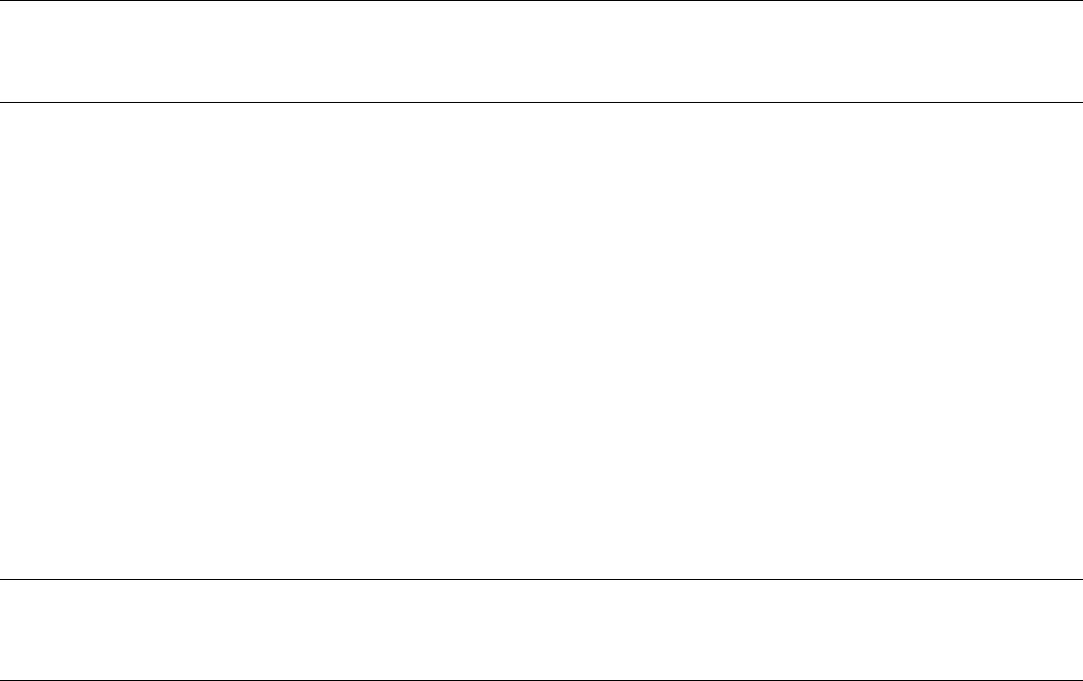
22. J.A. Pineault and M.E. Brauss, In Situ Measurement of Residual and Applied Stresses in Pressure
Vessels and Pipeline Using X-ray Diffraction Techniques, Determining Material Characterization:
Residual Stress and Integrity with NDE, PUP-Vol 276, NDE-Vol 12, American Society of Mechanical
Engineers, New York, 1994
Residual Stress Measurements
Clayton O. Ruud, The Pennsylvania State University
Stress Measurement
A number of procedures and methods have been applied to determining the residual stresses extant in a metallic
component, usually as a result of manufacturing processing. However, stress is never the quantity measured,
because stress is a quantity that is applied to a metal and can only be measured in the process of its application.
What is invariably measured to determine residual stress is elastic strain—either the elastic strain resulting
directly from the existing residual stress in the metal or the elastic strain change resulting from relief of some
portion or all of the existing residual stress. The stress that is causing, or has caused, the strain is then calculated
using the applicable elastic constants for the metal.
The methods described in the section “Nondestructive Procedures” in this article directly or indirectly measure
the strain response of metals to the residual stress in situ, while the destructive and semidestructive methods
described in the following sections measure the strain change caused in relieving some or all of the residual
stress in the metal.
Residual Stress Measurements
Clayton O. Ruud, The Pennsylvania State University
Destructive Measurement Procedures (Stress-Relaxation Techniques)
The first concern in selecting a destructive residual stress measurement procedure is whether it is reasonable to
destroy one or more components or samples in order to determine the residual stresses. Usually this implies that
one or a few of the components are a small portion of the total number produced. Also coupled to this decision
is whether the one or more components in which the residual stresses are to be measured are representative of
all the others. In other words, how great is the expected variation of the residual stress field from part to part?
As mentioned at the beginning of this article, the need for the residual stress information on a component must
be clearly understood. This includes whether the triaxial stress field must be established or if the uniaxial or
biaxial condition of the stress field along specific directions is sufficient. Examples of these three situations are
illustrated in this subsection. However, in any case, the fact that residual stresses are usually not uniform in any
direction and show high stress gradients must be kept in mind when stress measurement criteria are selected.
Destructive methods of residual stress measurement are fundamentally stress-relaxation procedures (techniques
A-1 and A-2 in Table 1). That is, the information is obtained by relaxing the residual stress in some finite
volume element of the component and measuring the resulting strain change. The strain change is then used,
along with applicable assumptions about the nature of the stress field, to reconstruct the original stress field.
Assumptions about the nature of the stress field include the magnitudes and gradients in the stress field and
whether it is sufficient to assume that the gradients are one-dimensional, two-dimensional, or three-
dimensional. In particular, the gradients that exist will dictate the size of the element that is to be isolated and
made stress-free, in that the higher the stress gradient, the smaller the finite element must be in the direction of
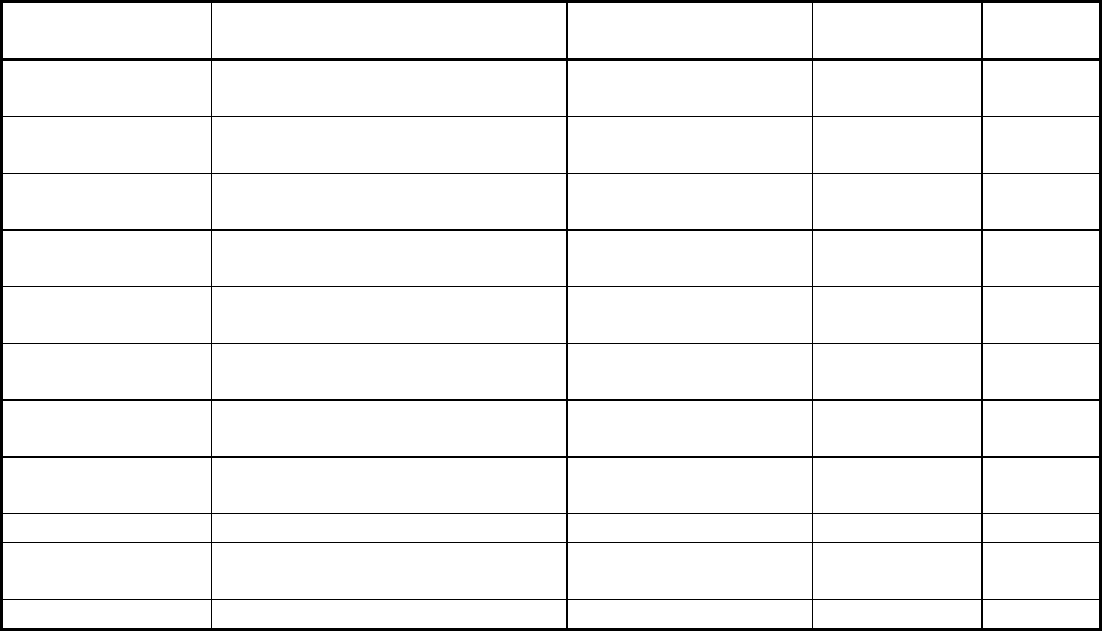
that gradient. It must be emphasized that the larger the element and the higher the stress gradient, the less
quantitative and more qualitative are the measurement results. Electrical resistance strain gage technologies will
be emphasized as the dominant method of strain change measurement for destructive and semidestructive stress
relaxation methods due to their economic, procedural, and precision advantages over other methods. However,
modern XRD stress measurement instrumentation (instruments designed specifically for stress measurement
and not conventional XRD instruments modified with stress measurement accessories) has all of these
advantages as well and can be used to measure the stresses existing before and after sectioning.
A generic destructive stress relief procedure will first be described along with the issues generally involved in
each procedural step. A summary of destructive residual stress measurement procedures is provided in Table 3.
This section on destructive methods concludes with discussion of qualitative chemical methods of residual
stress measurement, which are listed in Table 1 under D.
Table 3 Summary of destructive residual stress measurement procedures
Component shape Stress field
condition assumptions
Stress direction
measured
Method
Reference
Rods, cylinders,
tubes
Uniaxial stresses; axial symmetry Longitudinal Bauer-Heyn
23
Rectangular cross
section, bar
Uniaxial stresses varying through
thickness
Longitudinal Stablein
24
Rods, cylinders,
tubes
Biaxial stresses; axial symmetry Longitudinal, radial Mesnager-
Sachs
25, 26
Plate, sheet Homogeneous planar; biaxial
stresses varying through thickness
Biaxial in the plane of
the component
Trenting and
Read
27
Plate, sheet Homogeneous planar; biaxial
stresses uniform through thickness
Biaxial in the plane of
the component
Gunnert
28
Plate, sheet Homogeneous planar; biaxial
stresses varying through thickness
Biaxial in the plane of
the component
Gunnert
5, 29
Plate, sheet Planar biaxial stresses varying
through thickness
Biaxial in the plane of
the component
Rosenthal and
Norton
30
Plate, sheet Planar biaxial stresses varying
through thickness
Biaxial in the plane of
the component
Moore and
Evans
6
Plate, sheet Triaxial All Chen
31
Cylinder, plate Various All Moore and
Evans
6
Plate, weldment Triaxial All Johanssen 32
Generic Destructive Procedure
Once the decision to destructively measure the residual stresses is made, the following steps are usually applied
in a typical stress-relief technique for residual stress measurement.
Stress Field Conditions. The engineering problem for which the residual stress information to be derived
destructively is needed must be analyzed. This need is often generated by failures of the component in service,
anticipated failures due to problems with similar components, or inconsistent mechanical test results, especially
in fatigue testing. Distortion of a product in storage or during manufacturing can also be a concern. The shape
of the component, that is, cylinder, disc, plate, and so on, or some irregular shape, must be considered. This
consideration, along with the process or processes by which residual stresses were introduced, must be
analyzed. From these considerations, the justification for assumptions regarding the condition of the residual
stress field can be established. This may lead to simplifying assumptions about the stress field condition, such
as axial symmetry for a cylinder in which the dominant residual stress field is due to quenching during heat
treat processing or stress uniformity in the surface plane of a plate where stress gradient with depth is the major
concern (see Fig. 3).
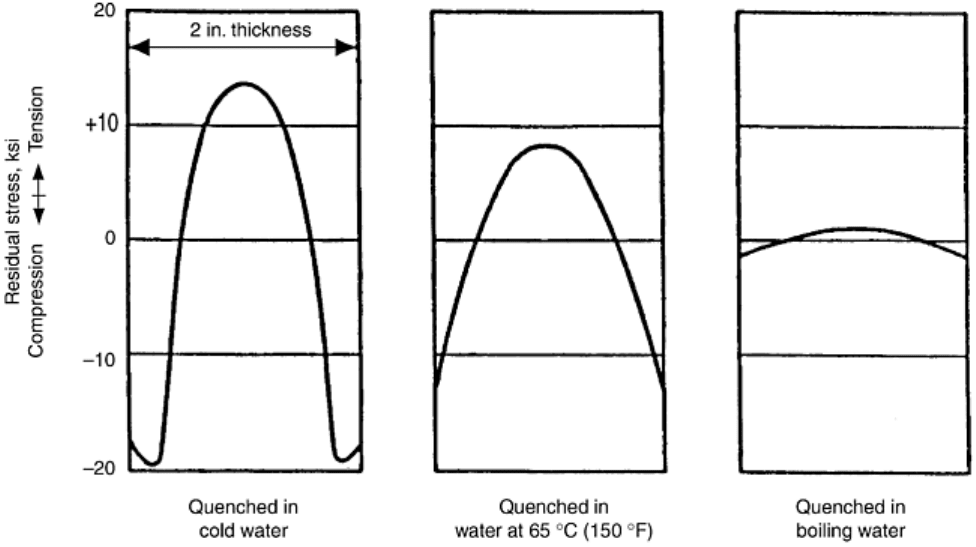
Fig. 3 Residual stresses in 7075-T6 plate specimens quenched in water at different temperatures
These assumptions and considerations lead to the methodology, that is, equations, to be used for computational
reconstruction of the stress fields from the measured strains for the destructive methods.
Strain Measurement Technique. With the stress reconstruction approach established, the method of strain
measurement and, consequently, the number and/or spatial frequency of measurements can be determined. The
strain measurement technique selected will greatly affect the resolution of the stress measurement because of
the spatial precision inherent in the technique.
There are a number of techniques that have been used to measure the strain induced by the relief of stresses due
to sectioning or material removal in destructive residual stress measurement. These include mechanical gages,
often dial gages, employed with specially made jigs and fixtures, reflected light schemes, photoelastic coatings,
and electrical resistance strain gages. However, over the last few decades, the use of the latter has become
dominant due to the variety, availability, and precision of these gages. They are available as uniaxial, biaxial,
and rosette gages of many sizes. The section “Strain Measurement Methods” of this article provides some detail
regarding these methods. Also, in the last several decades, extensive use of XRD to provide rapid and numerous
stress measurements on sectioned components so as to provide information regarding the internal stress field
has been applied (Ref 6, 32, 33, 34, and 35).
Preparation for Strain Measurement. With the strain measurement technique selected, the measurement location
must be established and the component and/or element prepared for the measurement by, for example, attaching
strain gages. A pre-stress-relaxation reading must be made before stress relaxation and isolation of the element
is initiated.
Isolation of Gaged Element. With the measurement technique in place, material removal to isolate the gaged
volume must be performed. The technique for material removal or sectioning must be carefully considered,
because mechanical chip removal processes such as lathe turning, milling, sawing, grinding, and so forth
introduce surface residual stresses that can be as great as the yield strength of the strain hardened material and
tens of micrometers (several thousandths of an inch) in depth (Ref 36, 37). The section “Sectioning and
Material Removal Methods” in this article discusses methods used to isolate the gaged element.
Post-Stress-Relaxation Measurement. After the residual stresses have been relaxed and, thus, the elements
isolated, strain measurements are repeated, and the final reading is subtracted from the initial one to obtain the
strain change resultant from the residual stress relaxation. The resultant quantities are then used in the residual
stress reconstruction equations to obtain the original stress state of the component. The stress reconstruction
equations were selected as a result of the assumptions made in the section “Stress Field Conditions” and
described in detail in following sections.
